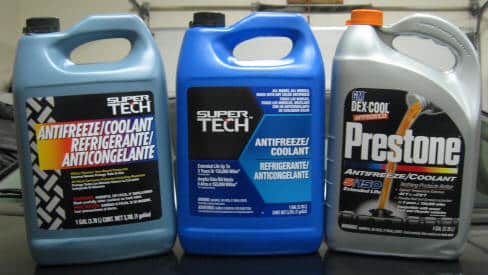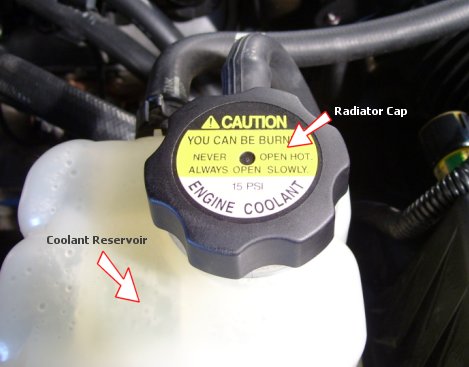Coolant is usually re green, blue, or yellow. If it looks colorless, looks rusty, or has things floating around in it, flush your cooling system and add new coolant. If the coolant has a sludgy, oily surface, immediately take the vehicle to your mechanic to check for internal head gasket leakage.
Discover below the car coolant functions: The purpose of coolants is to control the temperatures of fluids and various engine parts in all weather conditions. Engine coolant , also known as antifreeze , is mixed with water to keep the radiator from freezing in extreme cold and overheating in extreme heat. There are many different types of coolant , so it’s important to know what variety is right for your car or truck. Much like engine oils, the differences between different coolant types is a bit of a mystery for most drivers.
At most, knowing one has the green stuff, some others have pink, blue, or red stuff is about as far as it goes — and that includes most real car geeks as well. Not applying the right amount of antifreeze to your radiator can cause your engine to overheat - leaving you with an undriveable vehicle and an expensive repair. Most modern cars have a sealed cooling system so they shouldn’t need any topping up – unless, of course, they’ve sprung a leak. Give your engine coolant and your cooling fan a check every couple of weeks so you can spot any problems early. A coolant flush and fill is a maintenance must that can be performed in your garage or driveway.
The most important is keeping the water in your radiator and engine from freezing in cold temps. Most cars (rear-engined cars like Porsches and the Toyota MR-being exceptions) have the radiator in the front of the car , right behind the grill.

Antifreeze serves a few purposes. Car engines create a great deal of energy by burning petrol or diesel. But what happens to a car when there’s no coolant in the system?
Engine coolant and antifreeze are two terms used to describe the liquid but in short, it is an additive that mixes with water that increases is freezing and boiling points. It is an essential fluid that your car requires in order to run properly. You’ll probably find that there’s a warning symbol on the cap too, which highlights the danger of unscrewing the cap when the engine is running or hot. Getting the right type for your car is even more vital now antifreeze has been made vehicle-specific. In your car , antifreeze works to prevent your engine from freezing up or overheating in extreme climates.
As the outside temperature rises and falls, coolant is circulated throughout the engine block to maintain optimal internal operating temperatures. The problethe “low coolant light” comes on in your car so you want to get to the shop and have the small leak repaired or system topped up, but you don’t want a relatively small service or repair to turn into much bigger problem by mistakenly adding the wrong type of coolant. Understanding what makes your coolant work as well as understanding the needs of your car will help you decide on the right mixture of water and antifreeze. A radiator flush is a great way to winterize your cars coolant.
It directs coolant around cylinder heads and valves to absorb their. If your car has overheated and you lost your coolant , in a pinch you could add water to the engine to get you through, but before you do anything make sure it has cooled down. What is the cooling system flush all about? Your cooling system is what keeps your car from overheating. It works by circulating a mixture of water and coolant through the engine.
The short answer is no, not all coolant is created equal. If your car still has R-1 you can purchase a retrofit kit to convert your car to R-134a. To recap, coolant is responsible for heating a car ’s interior and cooling the car ’s engine.

To add coolant to a car , open the hoo and remove the cap on the white plastic tank that is next to the radiator. Add a 1:mixture of coolant and water up to the full mark, and replace the cap. Ensure that the car is in park and the engine is cool before opening the reservoir. Do you need to use the proper coolant in your car ? You probably need to follow the the manufacturer recommendation.
Using the wrong coolant can cause several issues with the coolant system. It’s special, and it requires special care and special coolant. Essential Things to Know About Your Car ’s Temperature Gauge A car temperature gauge shows how hot the engine is.
If the temperature gauge reads high, your car could be leaking coolant or have a bad water pump. Pour in the correct amount of antifreeze , then top up with water or mix the antifreeze solution in a watering-can and use that to pour it in. If your car has an expansion tank , replace the coolant there with the correct mixture, but do not fill the expansion tank to the top.
Older cars have “open” cooling systems, where the radiator cap doesn’t completely seal the system. At the same time, coolants also keep vehicles from freezing in cold weather (winter) as antifreeze includes ingredients that don’t freeze in ice cold temperature. You must have noticed that your car ’s hood becomes hot after it has been running for some time. If the engine is still hot, leave the hood open for several hours to allow the engine to cool down before attempting to add coolant.
Radiators are made up of different metals. Lots of different metals involved. The coolant circulates through the water jackets of the engine block.
Regular water will allow the cast iron block to rust or calcify. Not as often as your oil does, but still, you will need to change or “flush” the coolant in your car. Engine coolant is also called antifreeze because chemicals are added to keep it from freezing in cold climates so you can continue to operate your vehicle.
The engine coolant is circulated through your engine block, radiator and heater core by the water pump. A car engine produces a lot of heat when it is running, and must be cooled continuously to avoid engine damage. A water-cooled engine block and cylinder head have interconnected coolant.
Many people who own classic cars accept engine overheating as a necessary evil, but you don’t have to. This isn’t truly a closed system.
No comments:
Post a Comment
Note: Only a member of this blog may post a comment.